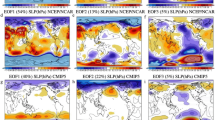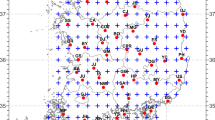Abstract
Siberian High pressure plays a significant role in wintertime climate variability over South Asia. It brings coldest air masses in the region. The available literature has linked Siberian High with climate of East Asia, central Asia, and Eurasia. This paper examines the linkage between Siberian High pressure and inter-annual variations in temperature over the region of South Asia during winters. The methods employed in this study are that of centers of action approach, maximum covariance, and canonical correlation analyses. The wintertime temperature is not only significantly influenced by the intensity of Siberian High pressure, but it is also significantly correlated with zonal movement of Indian Ocean High. The intensity of Siberian High pressure explains more variance of the temperature during winters over the South Asian region than that of large-scale circulation phenomena, namely, Arctic Oscillation, North Atlantic Oscillation, and El-Nino-Southern Oscillation. A linear model of wintertime temperature has also been constructed using the Siberian High pressure index and the Indian Ocean High longitudinal index, which explains 28% variability of wintertime temperature for the Northern part of South Asia. We have also presented the justification that this statistical evidence is supported by the circulations and changes in the atmosphere. The modes having maximum possible covariance between the regional wintertime temperature and sea-level pressure of Siberian High have been isolated using the method of maximum covariance analysis and the modes having maximum possible correlations between the two fields have been isolated using canonical correlation analysis.
















Similar content being viewed by others
References
Agnihotri C, Singh M (1982) Satellite study of western disturbances. Mausam 33:249–254
Bakalian F, Hameed S, Pickart R (2007) Influence of Icelandic Low latitude on the frequency of Greenland tip jet events: implications for Irminger Sea convection. J Geophys Res. doi:10.1029/2006JC003807
Bretherton CS, Smith C, Wallace JM (1992) An intercomparison of methods for finding coupled patterns in the climate data. J Clim 5:541–560
Cherry S (1997) Some comments on singular value decomposition analysis. J Clim 10:1759–1761
Cohen J, Saito K, Entekhabi D (2001) The role of the Siberian High in Northern Hemisphere climate variability. Geophys Res Lett 28(2):299–302
Dimri AP, Dash SK (2012) Wintertime climatic trends in the western Himalayas. Clim Change. doi:10.1007/s10584-011-0201-y
Dimri A, Niyogi D, Barros A, Ridley J, Mohanty U, Yasunari T, Sikka D (2015) Western disturbances: a review. Rev Geophys 53:225–246. doi:10.1002/2014/RG000460
Gong D-Y, Ho C-H (2002) The Siberian High and climate change over middle to high latitude Asia. Theor Appl Climatol 72:1–9
Hameed S, Piontkovski S (2004) The dominant influence of the Icelandic Low on the position of the Gulfstream northwall. Geophys Res Lett 31:L09303. doi:10.1029/2004GL019561
Hameed S, Riemer N (2012) Relationship between Sahel precipitation and atmospheric centers of action. Adv Meteorol. doi:10.1155/2012/953853
Hameed S, Shi W, Boyle J, Santer B (1995) Investigation of the centers of action in the North Atlantic and North Pacific in the ECHAM AMIP simulation. In: First international AMIP scientific conference Monterey. WRCP 92, California, p 221
Hameed S, Iqbal MJ, Rehman SU, Collins D (2011) Impact of the Indian Ocean high pressure system on winter precipitation over Western and Southwestern Australia. Aust Meteorol Oceanogr J 61:159–170
Hasanean HM, Almazroui M, Jones P, Alamoudi A (2013) Siberian High variability and its teleconnection with tropical circulations and surface air temperature over Saudi Arabia. Clim Dyn. doi:10.1007/s00382-012-1657-9
Huang F, Yi Z, Zhou FX (2000) The regional air-sea coupled oscillation in the South China Sea. Chin J Oceanol 18(1):25–34
Iqbal MJ, Ilyas K (2013) Influence of Icelandic Low pressure on winter precipitation variability over northern part of Indo-Pak region. Arab J Geosci. doi:10.1007/s12517-011-0355-y
Iqbal MJ, Riaz SM, Ghauri BM (2013) Impact of Siberian High on rainfall variability over Northern part of Indo-Pak region. Arab J Geosci. doi:10.1007/s12517-012-0598-2
Jeong J-H, Ou T, Linderholm H, Kim B-M, Kim S-J, Kug J-S, Chen D (2011) Recent recovery of the Siberian High intensity. J Geophys Res. doi:10.1029/2011/JDO15904
Jones JE, Cohen J (2011) A diagnostic comparison of Alaskan and Siberian strong anticyclones. J Clim 24:2599–2611
Kalnay E et al (1996) The NCEP/NCAR 40-year Reanalysis Project. Bull Am Meteorol Soc 77(3):437–472
Klopper E, Landman WA, Heerden JV (1998) The predictability of seasonal maximum temperature in South Africa. Int J Climatol 18(7):741–758
Liu Y, Wang L, Zhou W, Chen W (2014) Three Eurasian teleconnection patterns: spatial structures, temporal variability, and associated winter climate anomalies. Clim Dyn. doi:10.1007/s00382-014-2163-z
Lydolf P (1977) Climates of the Soviet Union. Elsevier, Amsterdam, p 443
Mooley D (1957) The role of western disturbances in the production of weather over India during different seasons. Indian J Meeorol Geophys 8:253–260
Panagiotopoulos F, Shahgedanova M, Hannachi A, Stephenson DB (2005) Observed trends and teleconnections of the Siberian High: a recently declining center of action. J Clim 18:1411–1422
Piontkovski S, Hameed S (2002) Precursors of copepod abundance in the Gulf main in atmospheric centers of action and sea surface temperature. Global Atmos Ocean Syst 8:283–291
Pisharoty P, Desai B (1956) Western disturbances and Indian weather. Indian J Meteorol 8:333–338
Revadekar JV, Hameed S, Collins D, Manton M, Sheikh M, Borgaonkar HP et al (2012) Impact of altitude and latitude on changes in temperature extremes over South Asia during 1971–2000. Int J Climatol. doi:10.1002/joc.3418
Riemer R, Doherty O, Hameed S (2006) On the variability of African dust transport across the Atlantic. Geophys Res Lett 33:L13814
Rossby C-G et al (1939) Relation between variations in the intensity of the zonal circulation of the atmosphere and the displacement of the semi-permanent centers of actions. J Mar Res 2(1):38–55
Syed F, Giorgi F, Pal J, King M (2006) Effect of remote forcings on the winter precipitation of central southwest Asia part 1: observations. Theor Appl Climatol 86:147–160. doi:10.1007/s00704-005-0217-1
Syed FS, Giorgi F, Pal J, Keay K (2010) Regional climate model simulation of winter climate over Central-Southwest Asia, with emphasis on NAO and ENSO effects. Int J Climatol 30:220–235. doi:10.1002/joc.1887
Yadav R, Kumar K, Rajeevan M (2007) Role of Indian Ocean sea surface temperatures in modulating northwest India winter precipitation variability. Theor Appl Climatol 87:73–83. doi:10.1007/s00704-005-0221-5
Yadav R, Kumar K, Rajeevan M (2009) Increasing influence of ENSO and decreasing influence of AO/NAO in the recent decades over northwest India winter precipitation. J Geophys Res 114:D12112. doi:10.1029/2008JD011318
Yadav R, Kumar K, Rajeevan M (2010a) Climate change scenarios for Northwest India winter season. Quatern Int 213:12–19. doi:10.1006/jquaint.2008.09.012
Yadav R, Yoo J, Kucharski F, Abid M (2010b) Why is ENSO influencing Northwest India winter precipitation in recent decades? J Clim 23:1979–1993. doi:10.1175/2009JCLI3202.1
Yadav R, Ramu D, Dimri A (2013) On the relationship between ENSO patterns and winter precipitation over North and Central India. Global Planet Change 107:50–58. doi:10.1016/j.gloplacha.2013.04.006
Author information
Authors and Affiliations
Corresponding author
Additional information
Responsible Editor: A. P. Dimri.
Rights and permissions
About this article
Cite this article
Riaz, S.M.F., Iqbal, M.J. & Baig, M.J. Influence of Siberian High on temperature variability over northern areas of South Asia. Meteorol Atmos Phys 130, 441–457 (2018). https://doi.org/10.1007/s00703-017-0531-z
Received:
Accepted:
Published:
Issue Date:
DOI: https://doi.org/10.1007/s00703-017-0531-z




